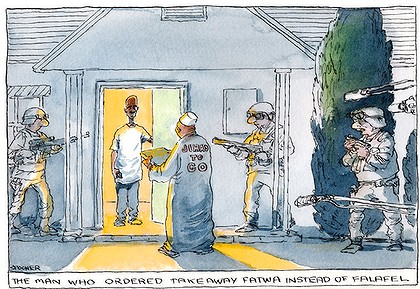Terror in our backyard
By Rajat Ganguly - www.theage.com.au | Thursday, 18 September 2014

A comprehensive strategy would help defuse the real threat to Australia's security, writes Rajat Ganguly.
THE arrests of four suspects in Melbourne on Tuesday, which are claimed to have foiled alleged plans for a terrorist attack against Holsworthy Barracks, provide a much needed wake-up call regarding Australia’s vulnerability to attacks from home-grown terrorists with links to foreign groups. As the Rudd Government searches for an appropriate response to this threat, it will be important to remember a few key lessons.
First, Australia’s support to the American-led ‘‘global war on terror’’ and its military involvement in Afghanistan and Iraq, has placed this country squarely in the crossfire of transnational Islamist terrorist organisations such as an invigorated al-Qaeda and its various affiliates.
Following the US invasion of Afghanistan in 2001, al-Qaeda was greatly weakened and its top leadership forced to seek shelter in the lawless Federally Administered Tribal Areas (FATA) in Pakistan’s north-west. But as the US attention shifted to Iraq, al-Qaeda regained its power and strengthened its contacts with militant Islamist organisations in various countries, including al-Shabab in Somalia.
In recent public pronouncements, both Osama bin Laden and Ayman al-Zawahiri,
al-Qaeda’s top leaders, have called on Islamist groups to strike at the US and its allies as a form of punishment for committing atrocities against Muslims in Afghanistan and Iraq.
So, the alleged plan to attack Holsworthy Barracks does not come as a total surprise. In a real and symbolic sense, it would have represented punishing the Australian military for its operations in Iraq and Afghanistan. It could also be intended to build public pressure for the withdrawal of our troops from Afghanistan.
A key lesson of the failed attack is this: we can no longer pretend that far-off terrorist groups do not pose an immediate and direct threat to the Australian homeland.
A second lesson is that it indicates that
al-Qaeda-inspired terrorist attacks against Australia are most likely to be organised and implemented by affiliates operating outside of the Middle East and west Asian regions.
Our focus is often in South-East Asia, where the main threat to Australia is posed by Jemaah Islamiah and its various factions. Al-Shabab in Somalia, however, poses a much bigger threat.
The organisation — whose name means ‘‘The Youth’’ in Arabic — grew out of the Somalia Islamic Courts Council that took control of most of southern Somalia for six months in 2006 but was then ousted from power by the US-backed government forces with support from the Ethiopian military. From early 2007, al-Shabab became the main Islamist resistance group in Somalia and this prompted a massive recruitment drive. Even though it was listed as a foreign terrorist organisation by the US government in February 2008 and its leader, Aden Hashi Ayro, was killed in a US air strike in May 2008, al-Shabab was able to grow rapidly taking advantage of the weak institutional capacity of the Somali Government and the widespread resentment generated by the presence of Ethiopian soldiers in the country.
By 2009, it was the main al-Qaeda affiliate operating in the Horn of Africa and controlled a vast area south of Mogadishu, the capital.
Many of its leaders, including Ayro, had strong links with al-Qaeda and had received training in terror camps in Afghanistan. With al-Qaeda’s help, al-Shabab began to organise terrorist trainingcamps in southern Somalia and trained a large number of foreign militants. The transnational reach of the organisation has, therefore, increased exponentially in recent times.
A third and final lesson of this week’s alleged terror plot is that groups such as al-Qaeda and al-Shabab are able to directly threaten Australia by activating ‘‘sleeper cells’’ here.
After the 2001 attacks on the US, Western states tightened their border security with the result that terrorist organisations started concentrating on recruiting personnel from inside Western countries.
Today there are undoubtedly autonomous sleeper cells in most Western states that could be activated as needed by groups like al-Qaeda and al-Shabab.
An Australian counterterrorism strategy must incorporate the following elements:
First, the reason Australian citizens, especially youth, are motivated to join terrorist organisations must be addressed and effectively neutralised.
This would require, among other things, a concerted national effort to win the war of ideas through sustained and deeper engagement with ethnic communities and community leaders.
Second, the capacity of domestic terrorist cells and their foreign sponsors to carry out attacks must be eliminated. The Melbourne arrests show that Australia’s security agencies are already doing this quiteeffectively.
Third, the identification of vulnerable targets that terrorist groups could strike and security in these areas must be increased. This applies particularly to transportation and communications infrastructure, military installations, water systems and power grids, government buildings, hotels, schools and hospitals.
Fourth, the legal system must be strengthened to ensure that people are deterred from committing acts of terrorism and terrorism-related offences.
Finally, it must be recognised that, in spite of our best efforts, terrorism remains a real possibility. Australia must have a rapid response and recovery system that can quickly restore calm and normalcy and provide needed assistance to victims.
After this week’s raid, one would hope that the Federal Government is already putting in place a strategy such as this.
Rajat Ganguly is program chair in Security, Terrorism and Counterterrorism Studies at Murdoch University.
comments
More headlines
Happy Kids Kindergarten in Sydney Announces Renovation
Armenian National Committee of Australia to Host Second Junior Advocates Program
The Armenian Film Festival Returns for 2024!
ARF Australia Protests Armenian Government Policies During Meeting with Sinanyan
MARCH TO FOREIGN AFFAIRS MINISTRY FRIDAY 1ST SEPTEMBER
PRESS RELEASE: Australian City Launches Humanitarian Appeal for Artsakh
PRESS RELEASE: The Armenian Film Festival Australia returns to Sydney and Melbourne!
MEDIA RELEASE: Joint Javakhk Committee TUMO Box Set for Launch in 2024